Detailed Technical and Environmental Analysis: London Array Wind Farm
VerifiedAdded on 2020/03/04
|17
|2911
|58
Report
AI Summary
This report provides a detailed analysis of the London Array Wind Farm, the world's first industrial-sized offshore wind farm. It begins with an introduction to the project, including its historical background and the need for renewable energy sources like wind farms. The report then delves into the conceptual design theory, covering aspects such as conceptual design, offshore design, operations and maintenance, and navigation and safety. A significant portion of the report is dedicated to a technical description of the wind farm, including wind turbine statistics and specifications. The report also includes discussions on the different types of wind turbines, their blades, and the offshore design considerations. The report concludes with a summary of the findings and provides references for further research. The report highlights the importance of the London Array Wind Farm as a significant renewable energy project and its contribution to sustainable energy generation.

Paraphrase This Document
Need a fresh take? Get an instant paraphrase of this document with our AI Paraphraser
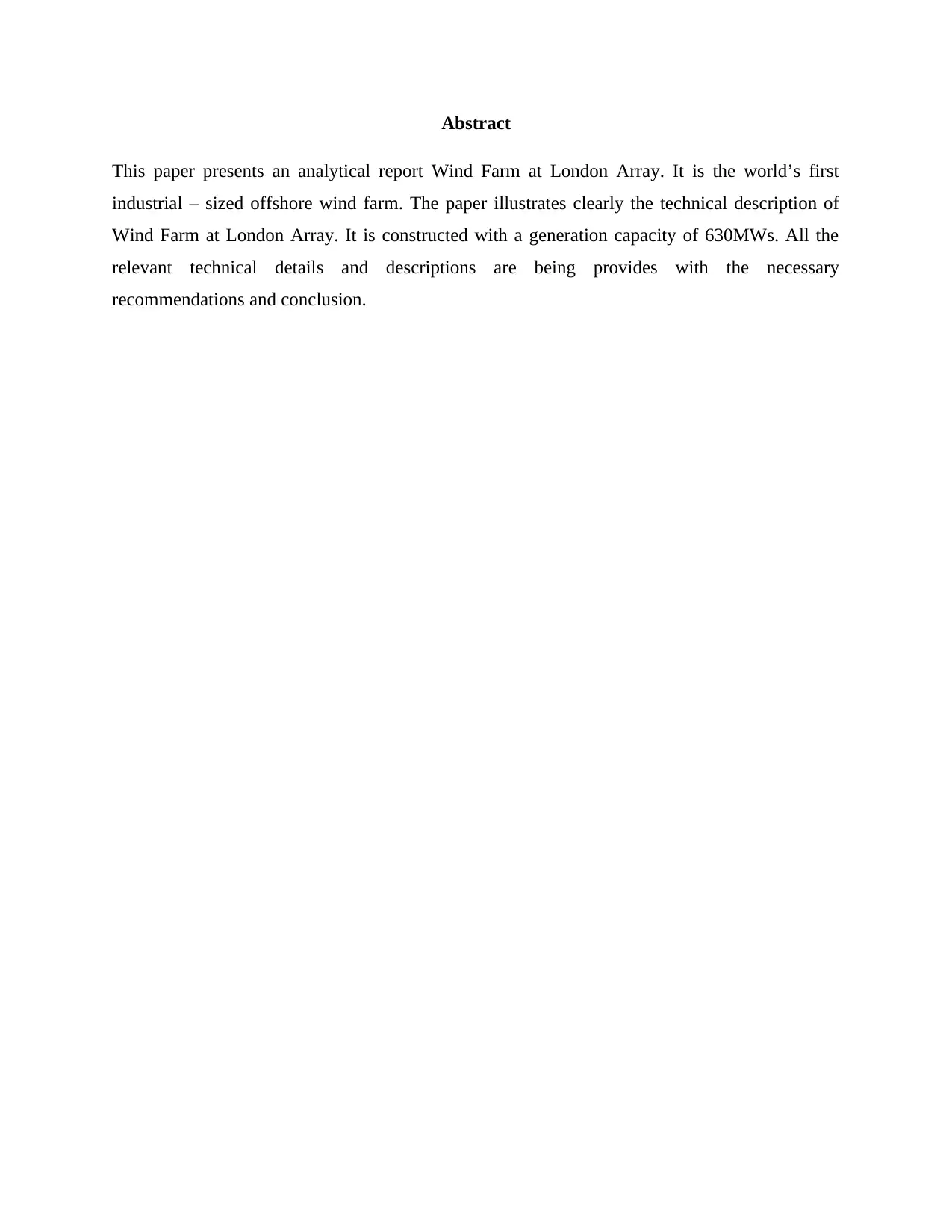
Abstract
This paper presents an analytical report Wind Farm at London Array. It is the world’s first
industrial – sized offshore wind farm. The paper illustrates clearly the technical description of
Wind Farm at London Array. It is constructed with a generation capacity of 630MWs. All the
relevant technical details and descriptions are being provides with the necessary
recommendations and conclusion.
This paper presents an analytical report Wind Farm at London Array. It is the world’s first
industrial – sized offshore wind farm. The paper illustrates clearly the technical description of
Wind Farm at London Array. It is constructed with a generation capacity of 630MWs. All the
relevant technical details and descriptions are being provides with the necessary
recommendations and conclusion.
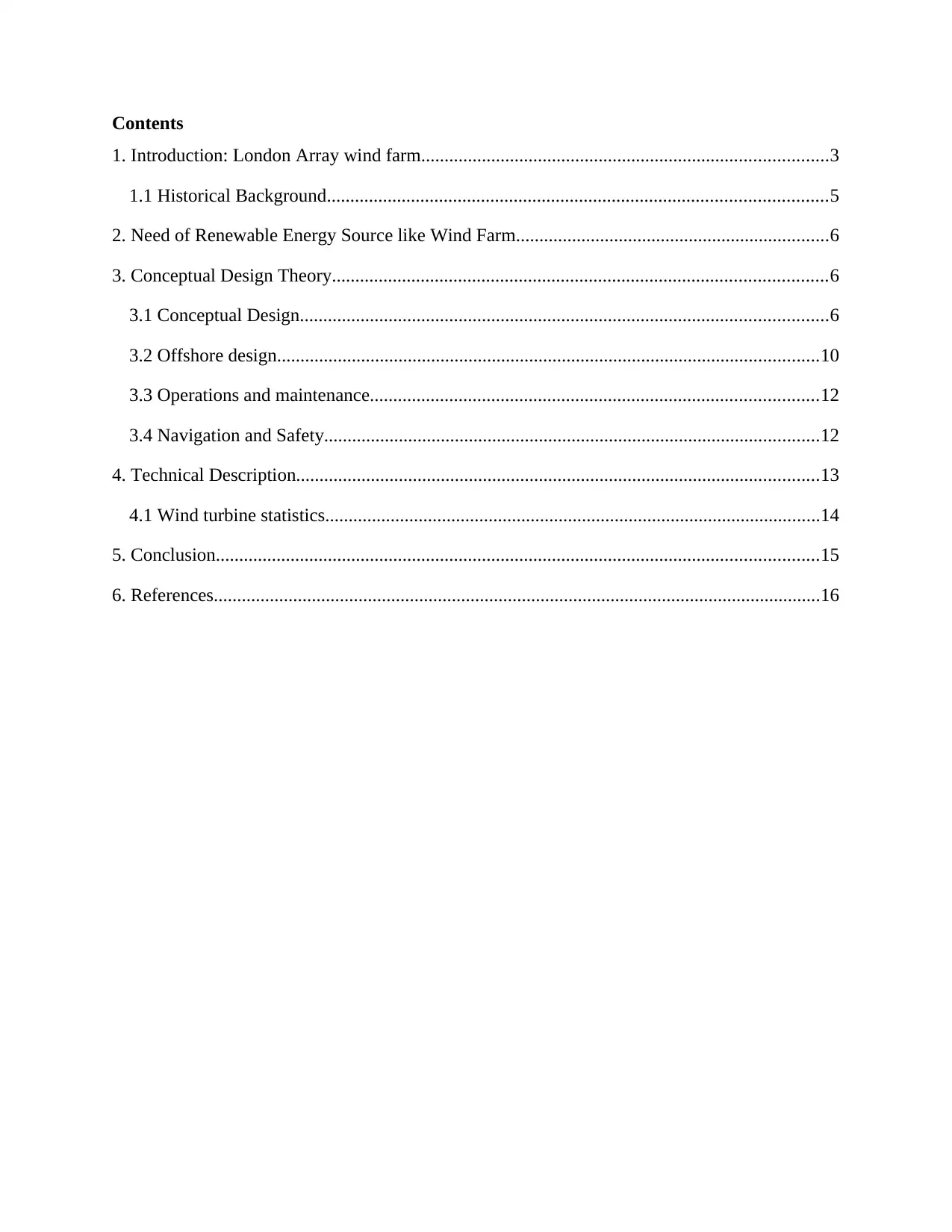
Contents
1. Introduction: London Array wind farm.......................................................................................3
1.1 Historical Background...........................................................................................................5
2. Need of Renewable Energy Source like Wind Farm...................................................................6
3. Conceptual Design Theory..........................................................................................................6
3.1 Conceptual Design.................................................................................................................6
3.2 Offshore design....................................................................................................................10
3.3 Operations and maintenance................................................................................................12
3.4 Navigation and Safety..........................................................................................................12
4. Technical Description................................................................................................................13
4.1 Wind turbine statistics..........................................................................................................14
5. Conclusion.................................................................................................................................15
6. References..................................................................................................................................16
1. Introduction: London Array wind farm.......................................................................................3
1.1 Historical Background...........................................................................................................5
2. Need of Renewable Energy Source like Wind Farm...................................................................6
3. Conceptual Design Theory..........................................................................................................6
3.1 Conceptual Design.................................................................................................................6
3.2 Offshore design....................................................................................................................10
3.3 Operations and maintenance................................................................................................12
3.4 Navigation and Safety..........................................................................................................12
4. Technical Description................................................................................................................13
4.1 Wind turbine statistics..........................................................................................................14
5. Conclusion.................................................................................................................................15
6. References..................................................................................................................................16
⊘ This is a preview!⊘
Do you want full access?
Subscribe today to unlock all pages.

Trusted by 1+ million students worldwide
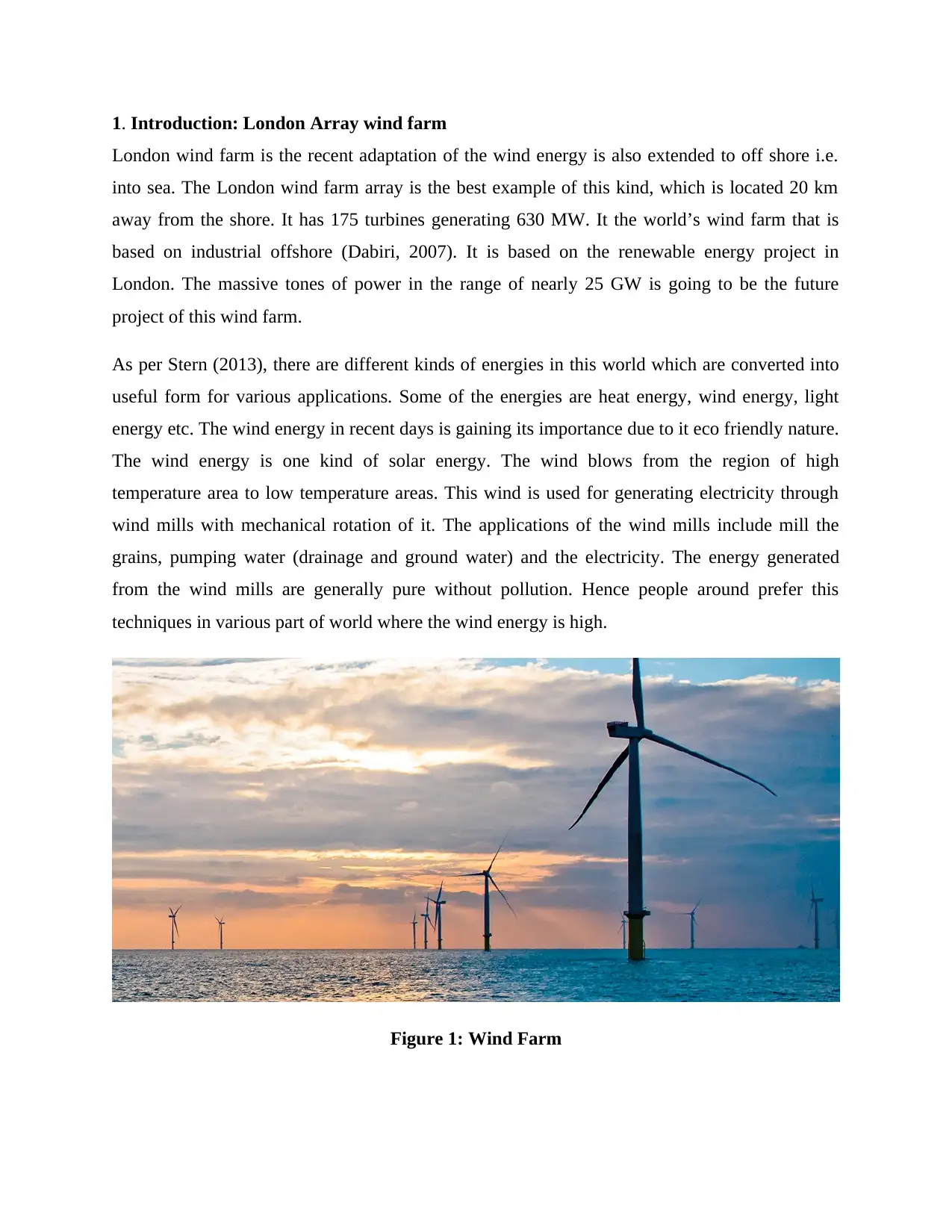
1. Introduction: London Array wind farm
London wind farm is the recent adaptation of the wind energy is also extended to off shore i.e.
into sea. The London wind farm array is the best example of this kind, which is located 20 km
away from the shore. It has 175 turbines generating 630 MW. It the world’s wind farm that is
based on industrial offshore (Dabiri, 2007). It is based on the renewable energy project in
London. The massive tones of power in the range of nearly 25 GW is going to be the future
project of this wind farm.
As per Stern (2013), there are different kinds of energies in this world which are converted into
useful form for various applications. Some of the energies are heat energy, wind energy, light
energy etc. The wind energy in recent days is gaining its importance due to it eco friendly nature.
The wind energy is one kind of solar energy. The wind blows from the region of high
temperature area to low temperature areas. This wind is used for generating electricity through
wind mills with mechanical rotation of it. The applications of the wind mills include mill the
grains, pumping water (drainage and ground water) and the electricity. The energy generated
from the wind mills are generally pure without pollution. Hence people around prefer this
techniques in various part of world where the wind energy is high.
Figure 1: Wind Farm
London wind farm is the recent adaptation of the wind energy is also extended to off shore i.e.
into sea. The London wind farm array is the best example of this kind, which is located 20 km
away from the shore. It has 175 turbines generating 630 MW. It the world’s wind farm that is
based on industrial offshore (Dabiri, 2007). It is based on the renewable energy project in
London. The massive tones of power in the range of nearly 25 GW is going to be the future
project of this wind farm.
As per Stern (2013), there are different kinds of energies in this world which are converted into
useful form for various applications. Some of the energies are heat energy, wind energy, light
energy etc. The wind energy in recent days is gaining its importance due to it eco friendly nature.
The wind energy is one kind of solar energy. The wind blows from the region of high
temperature area to low temperature areas. This wind is used for generating electricity through
wind mills with mechanical rotation of it. The applications of the wind mills include mill the
grains, pumping water (drainage and ground water) and the electricity. The energy generated
from the wind mills are generally pure without pollution. Hence people around prefer this
techniques in various part of world where the wind energy is high.
Figure 1: Wind Farm
Paraphrase This Document
Need a fresh take? Get an instant paraphrase of this document with our AI Paraphraser
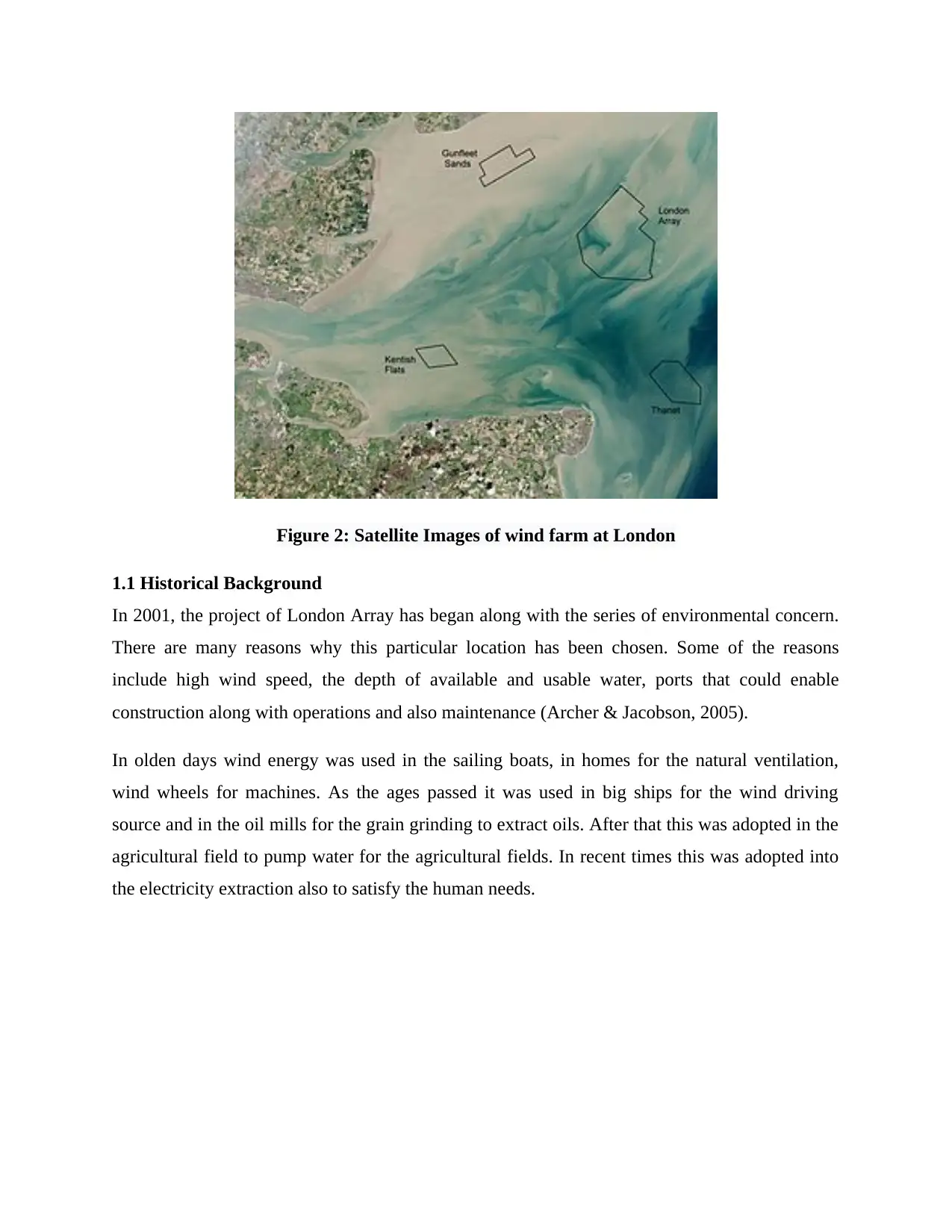
Figure 2: Satellite Images of wind farm at London
1.1 Historical Background
In 2001, the project of London Array has began along with the series of environmental concern.
There are many reasons why this particular location has been chosen. Some of the reasons
include high wind speed, the depth of available and usable water, ports that could enable
construction along with operations and also maintenance (Archer & Jacobson, 2005).
In olden days wind energy was used in the sailing boats, in homes for the natural ventilation,
wind wheels for machines. As the ages passed it was used in big ships for the wind driving
source and in the oil mills for the grain grinding to extract oils. After that this was adopted in the
agricultural field to pump water for the agricultural fields. In recent times this was adopted into
the electricity extraction also to satisfy the human needs.
1.1 Historical Background
In 2001, the project of London Array has began along with the series of environmental concern.
There are many reasons why this particular location has been chosen. Some of the reasons
include high wind speed, the depth of available and usable water, ports that could enable
construction along with operations and also maintenance (Archer & Jacobson, 2005).
In olden days wind energy was used in the sailing boats, in homes for the natural ventilation,
wind wheels for machines. As the ages passed it was used in big ships for the wind driving
source and in the oil mills for the grain grinding to extract oils. After that this was adopted in the
agricultural field to pump water for the agricultural fields. In recent times this was adopted into
the electricity extraction also to satisfy the human needs.
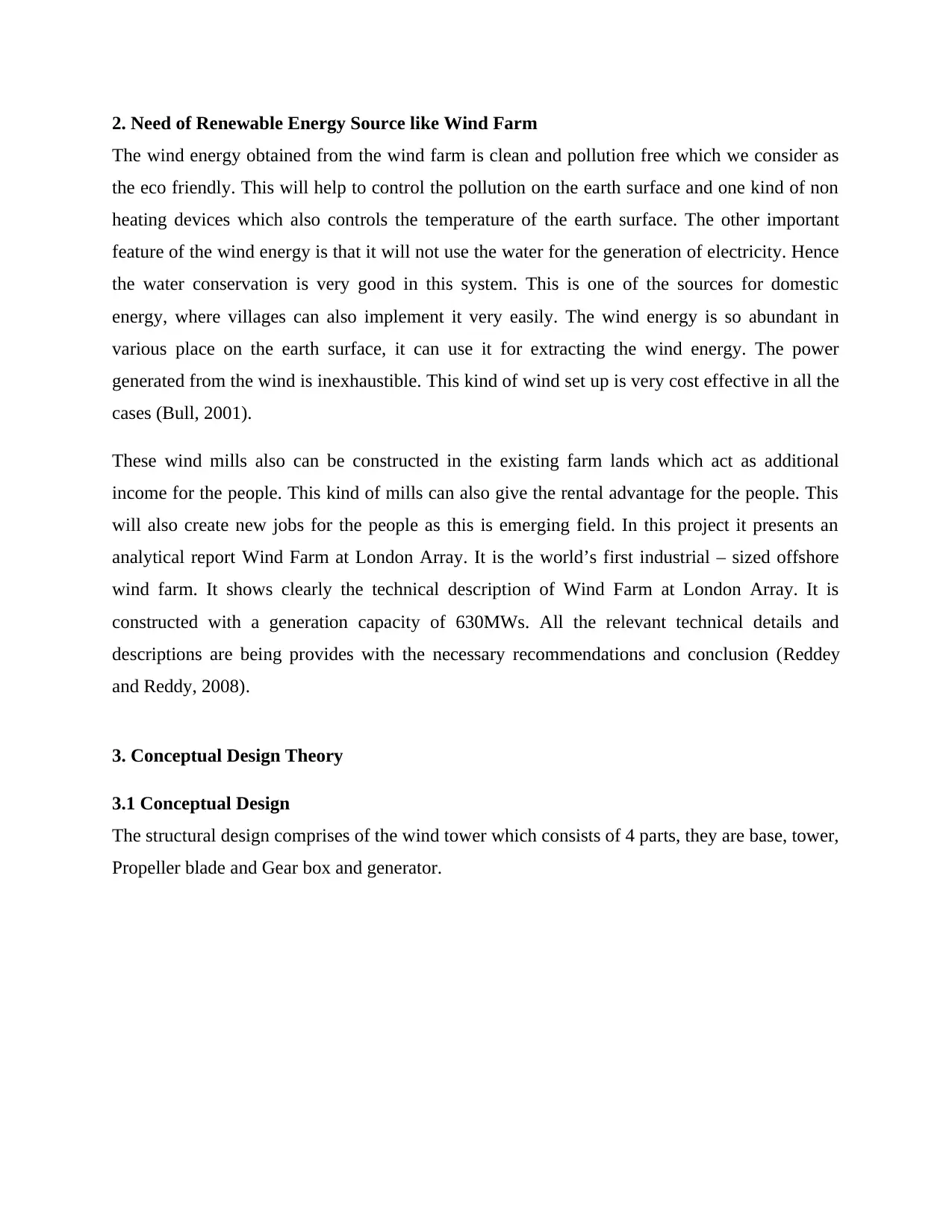
2. Need of Renewable Energy Source like Wind Farm
The wind energy obtained from the wind farm is clean and pollution free which we consider as
the eco friendly. This will help to control the pollution on the earth surface and one kind of non
heating devices which also controls the temperature of the earth surface. The other important
feature of the wind energy is that it will not use the water for the generation of electricity. Hence
the water conservation is very good in this system. This is one of the sources for domestic
energy, where villages can also implement it very easily. The wind energy is so abundant in
various place on the earth surface, it can use it for extracting the wind energy. The power
generated from the wind is inexhaustible. This kind of wind set up is very cost effective in all the
cases (Bull, 2001).
These wind mills also can be constructed in the existing farm lands which act as additional
income for the people. This kind of mills can also give the rental advantage for the people. This
will also create new jobs for the people as this is emerging field. In this project it presents an
analytical report Wind Farm at London Array. It is the world’s first industrial – sized offshore
wind farm. It shows clearly the technical description of Wind Farm at London Array. It is
constructed with a generation capacity of 630MWs. All the relevant technical details and
descriptions are being provides with the necessary recommendations and conclusion (Reddey
and Reddy, 2008).
3. Conceptual Design Theory
3.1 Conceptual Design
The structural design comprises of the wind tower which consists of 4 parts, they are base, tower,
Propeller blade and Gear box and generator.
The wind energy obtained from the wind farm is clean and pollution free which we consider as
the eco friendly. This will help to control the pollution on the earth surface and one kind of non
heating devices which also controls the temperature of the earth surface. The other important
feature of the wind energy is that it will not use the water for the generation of electricity. Hence
the water conservation is very good in this system. This is one of the sources for domestic
energy, where villages can also implement it very easily. The wind energy is so abundant in
various place on the earth surface, it can use it for extracting the wind energy. The power
generated from the wind is inexhaustible. This kind of wind set up is very cost effective in all the
cases (Bull, 2001).
These wind mills also can be constructed in the existing farm lands which act as additional
income for the people. This kind of mills can also give the rental advantage for the people. This
will also create new jobs for the people as this is emerging field. In this project it presents an
analytical report Wind Farm at London Array. It is the world’s first industrial – sized offshore
wind farm. It shows clearly the technical description of Wind Farm at London Array. It is
constructed with a generation capacity of 630MWs. All the relevant technical details and
descriptions are being provides with the necessary recommendations and conclusion (Reddey
and Reddy, 2008).
3. Conceptual Design Theory
3.1 Conceptual Design
The structural design comprises of the wind tower which consists of 4 parts, they are base, tower,
Propeller blade and Gear box and generator.
⊘ This is a preview!⊘
Do you want full access?
Subscribe today to unlock all pages.

Trusted by 1+ million students worldwide
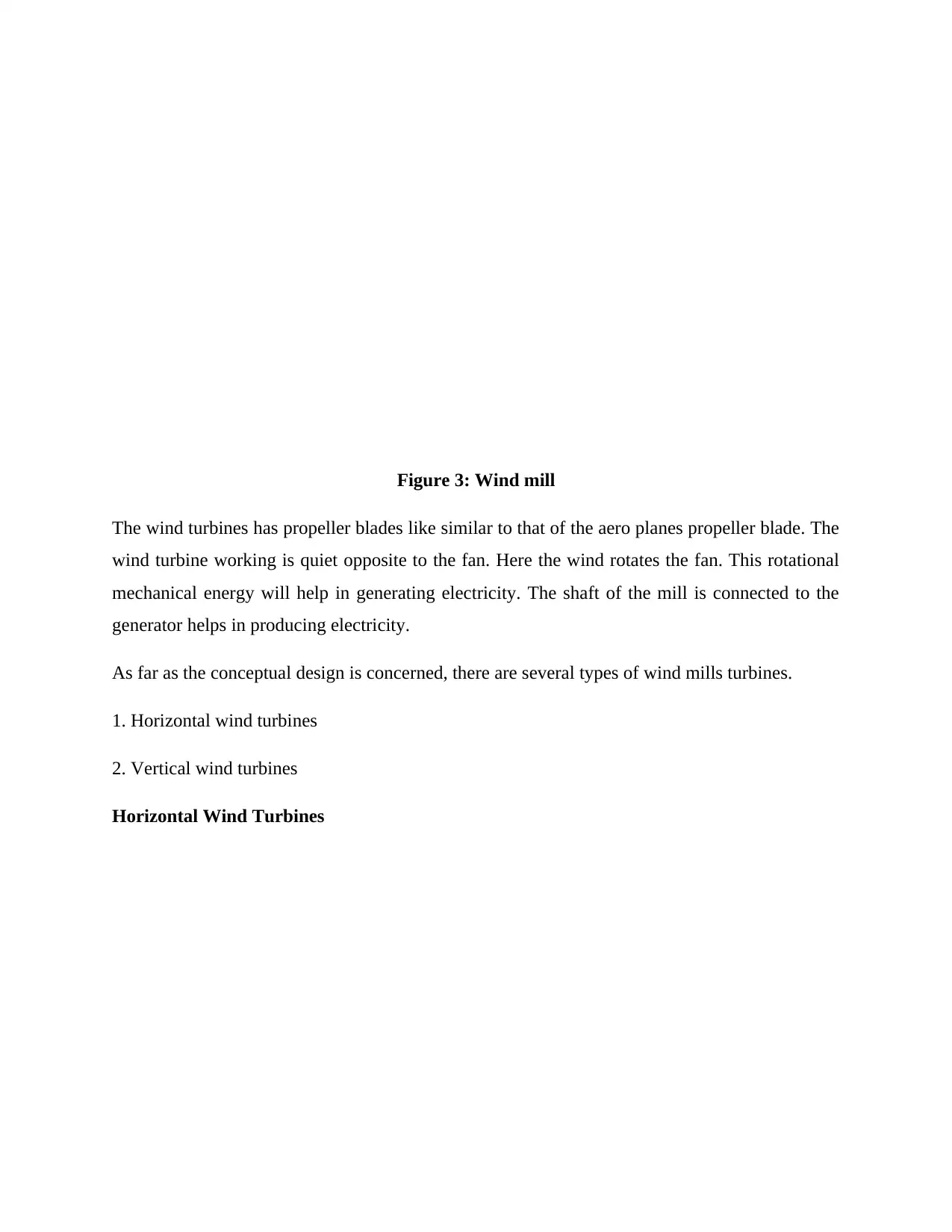
Figure 3: Wind mill
The wind turbines has propeller blades like similar to that of the aero planes propeller blade. The
wind turbine working is quiet opposite to the fan. Here the wind rotates the fan. This rotational
mechanical energy will help in generating electricity. The shaft of the mill is connected to the
generator helps in producing electricity.
As far as the conceptual design is concerned, there are several types of wind mills turbines.
1. Horizontal wind turbines
2. Vertical wind turbines
Horizontal Wind Turbines
The wind turbines has propeller blades like similar to that of the aero planes propeller blade. The
wind turbine working is quiet opposite to the fan. Here the wind rotates the fan. This rotational
mechanical energy will help in generating electricity. The shaft of the mill is connected to the
generator helps in producing electricity.
As far as the conceptual design is concerned, there are several types of wind mills turbines.
1. Horizontal wind turbines
2. Vertical wind turbines
Horizontal Wind Turbines
Paraphrase This Document
Need a fresh take? Get an instant paraphrase of this document with our AI Paraphraser
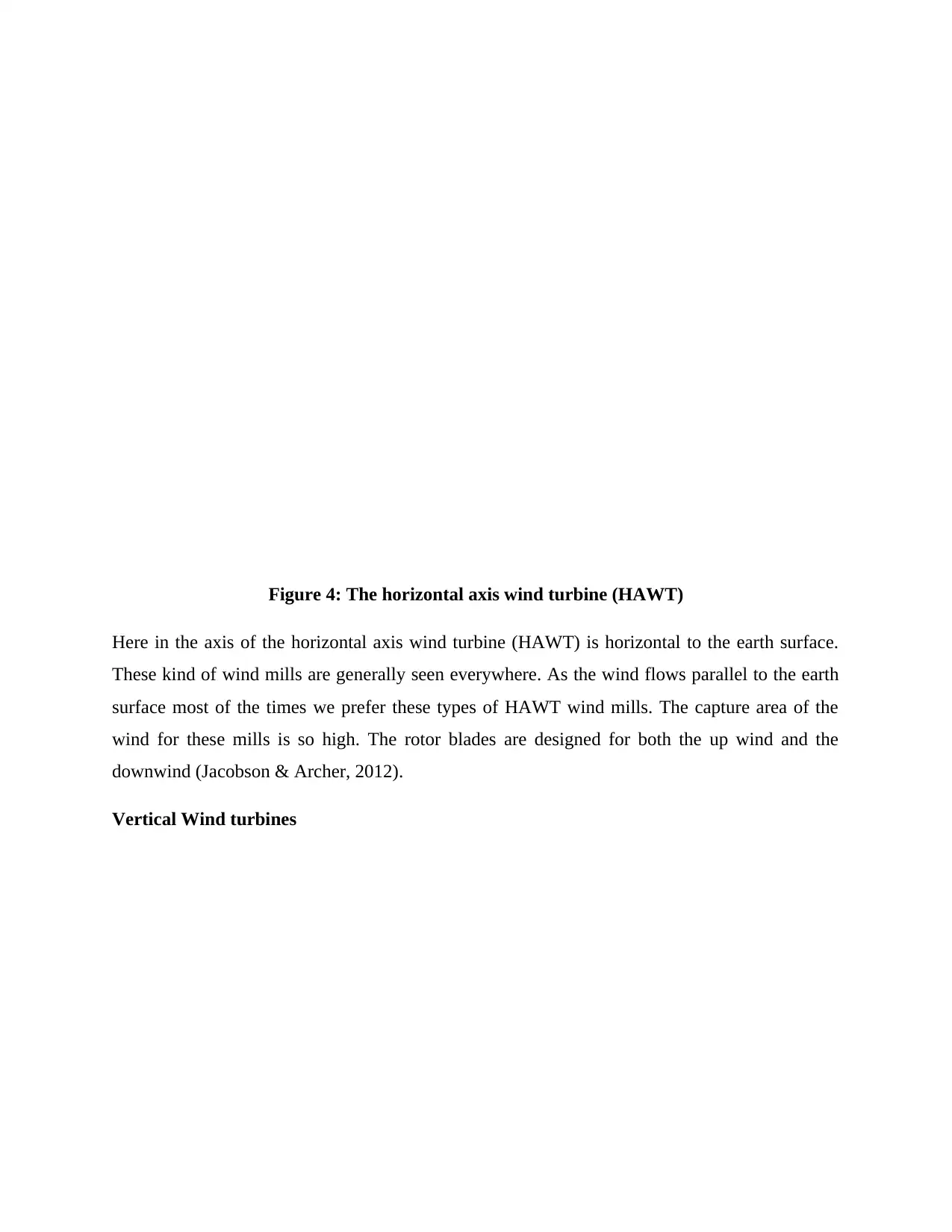
Figure 4: The horizontal axis wind turbine (HAWT)
Here in the axis of the horizontal axis wind turbine (HAWT) is horizontal to the earth surface.
These kind of wind mills are generally seen everywhere. As the wind flows parallel to the earth
surface most of the times we prefer these types of HAWT wind mills. The capture area of the
wind for these mills is so high. The rotor blades are designed for both the up wind and the
downwind (Jacobson & Archer, 2012).
Vertical Wind turbines
Here in the axis of the horizontal axis wind turbine (HAWT) is horizontal to the earth surface.
These kind of wind mills are generally seen everywhere. As the wind flows parallel to the earth
surface most of the times we prefer these types of HAWT wind mills. The capture area of the
wind for these mills is so high. The rotor blades are designed for both the up wind and the
downwind (Jacobson & Archer, 2012).
Vertical Wind turbines
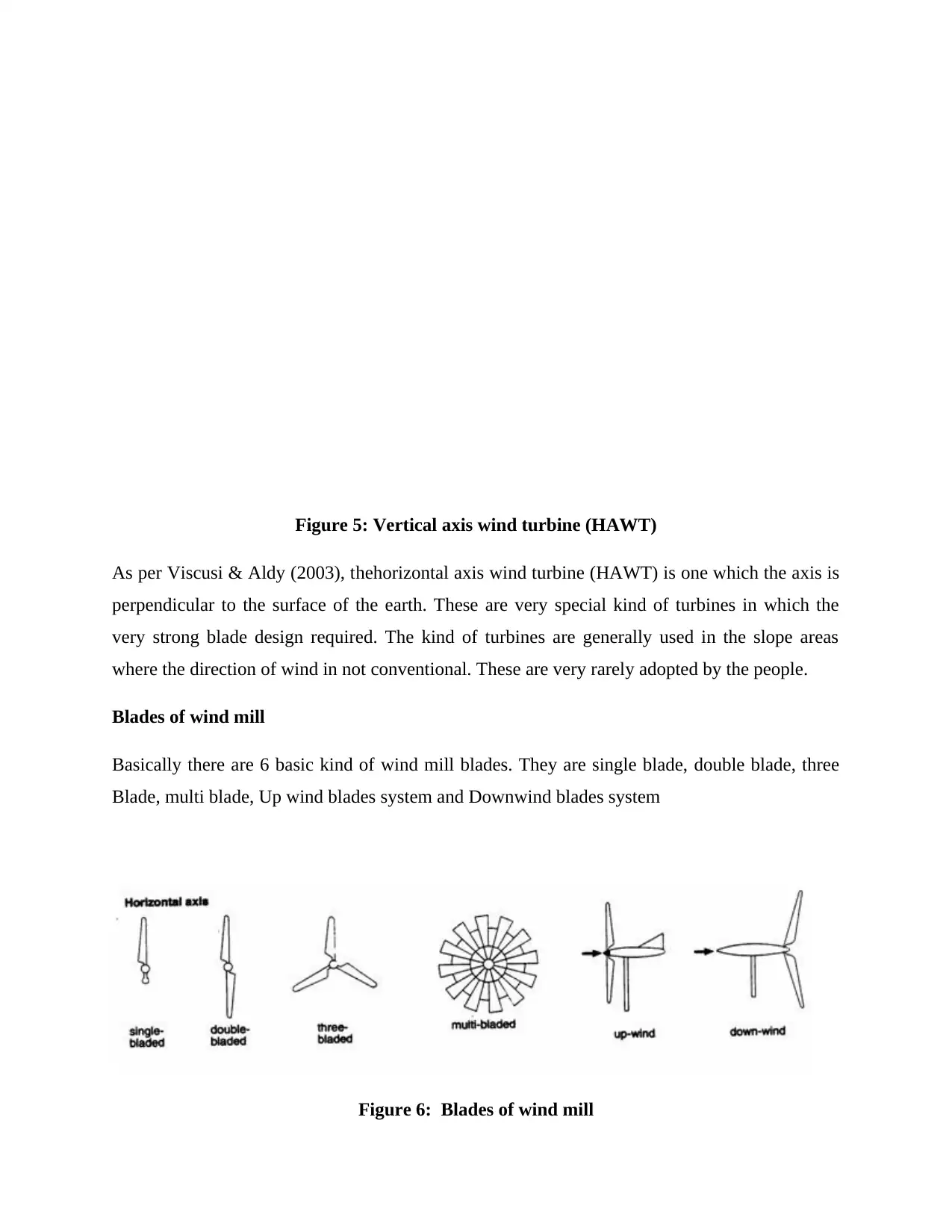
Figure 5: Vertical axis wind turbine (HAWT)
As per Viscusi & Aldy (2003), thehorizontal axis wind turbine (HAWT) is one which the axis is
perpendicular to the surface of the earth. These are very special kind of turbines in which the
very strong blade design required. The kind of turbines are generally used in the slope areas
where the direction of wind in not conventional. These are very rarely adopted by the people.
Blades of wind mill
Basically there are 6 basic kind of wind mill blades. They are single blade, double blade, three
Blade, multi blade, Up wind blades system and Downwind blades system
Figure 6: Blades of wind mill
As per Viscusi & Aldy (2003), thehorizontal axis wind turbine (HAWT) is one which the axis is
perpendicular to the surface of the earth. These are very special kind of turbines in which the
very strong blade design required. The kind of turbines are generally used in the slope areas
where the direction of wind in not conventional. These are very rarely adopted by the people.
Blades of wind mill
Basically there are 6 basic kind of wind mill blades. They are single blade, double blade, three
Blade, multi blade, Up wind blades system and Downwind blades system
Figure 6: Blades of wind mill
⊘ This is a preview!⊘
Do you want full access?
Subscribe today to unlock all pages.

Trusted by 1+ million students worldwide
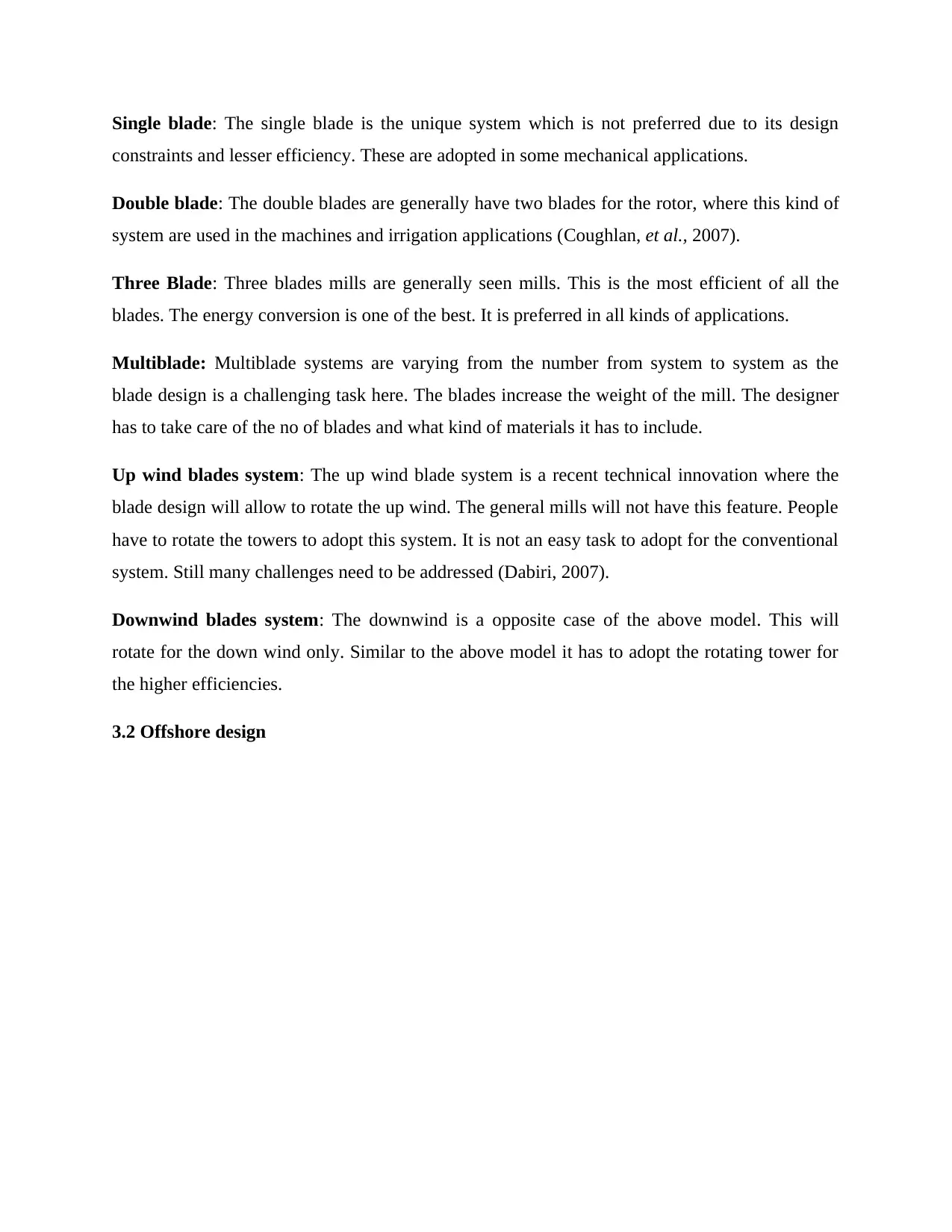
Single blade: The single blade is the unique system which is not preferred due to its design
constraints and lesser efficiency. These are adopted in some mechanical applications.
Double blade: The double blades are generally have two blades for the rotor, where this kind of
system are used in the machines and irrigation applications (Coughlan, et al., 2007).
Three Blade: Three blades mills are generally seen mills. This is the most efficient of all the
blades. The energy conversion is one of the best. It is preferred in all kinds of applications.
Multiblade: Multiblade systems are varying from the number from system to system as the
blade design is a challenging task here. The blades increase the weight of the mill. The designer
has to take care of the no of blades and what kind of materials it has to include.
Up wind blades system: The up wind blade system is a recent technical innovation where the
blade design will allow to rotate the up wind. The general mills will not have this feature. People
have to rotate the towers to adopt this system. It is not an easy task to adopt for the conventional
system. Still many challenges need to be addressed (Dabiri, 2007).
Downwind blades system: The downwind is a opposite case of the above model. This will
rotate for the down wind only. Similar to the above model it has to adopt the rotating tower for
the higher efficiencies.
3.2 Offshore design
constraints and lesser efficiency. These are adopted in some mechanical applications.
Double blade: The double blades are generally have two blades for the rotor, where this kind of
system are used in the machines and irrigation applications (Coughlan, et al., 2007).
Three Blade: Three blades mills are generally seen mills. This is the most efficient of all the
blades. The energy conversion is one of the best. It is preferred in all kinds of applications.
Multiblade: Multiblade systems are varying from the number from system to system as the
blade design is a challenging task here. The blades increase the weight of the mill. The designer
has to take care of the no of blades and what kind of materials it has to include.
Up wind blades system: The up wind blade system is a recent technical innovation where the
blade design will allow to rotate the up wind. The general mills will not have this feature. People
have to rotate the towers to adopt this system. It is not an easy task to adopt for the conventional
system. Still many challenges need to be addressed (Dabiri, 2007).
Downwind blades system: The downwind is a opposite case of the above model. This will
rotate for the down wind only. Similar to the above model it has to adopt the rotating tower for
the higher efficiencies.
3.2 Offshore design
Paraphrase This Document
Need a fresh take? Get an instant paraphrase of this document with our AI Paraphraser
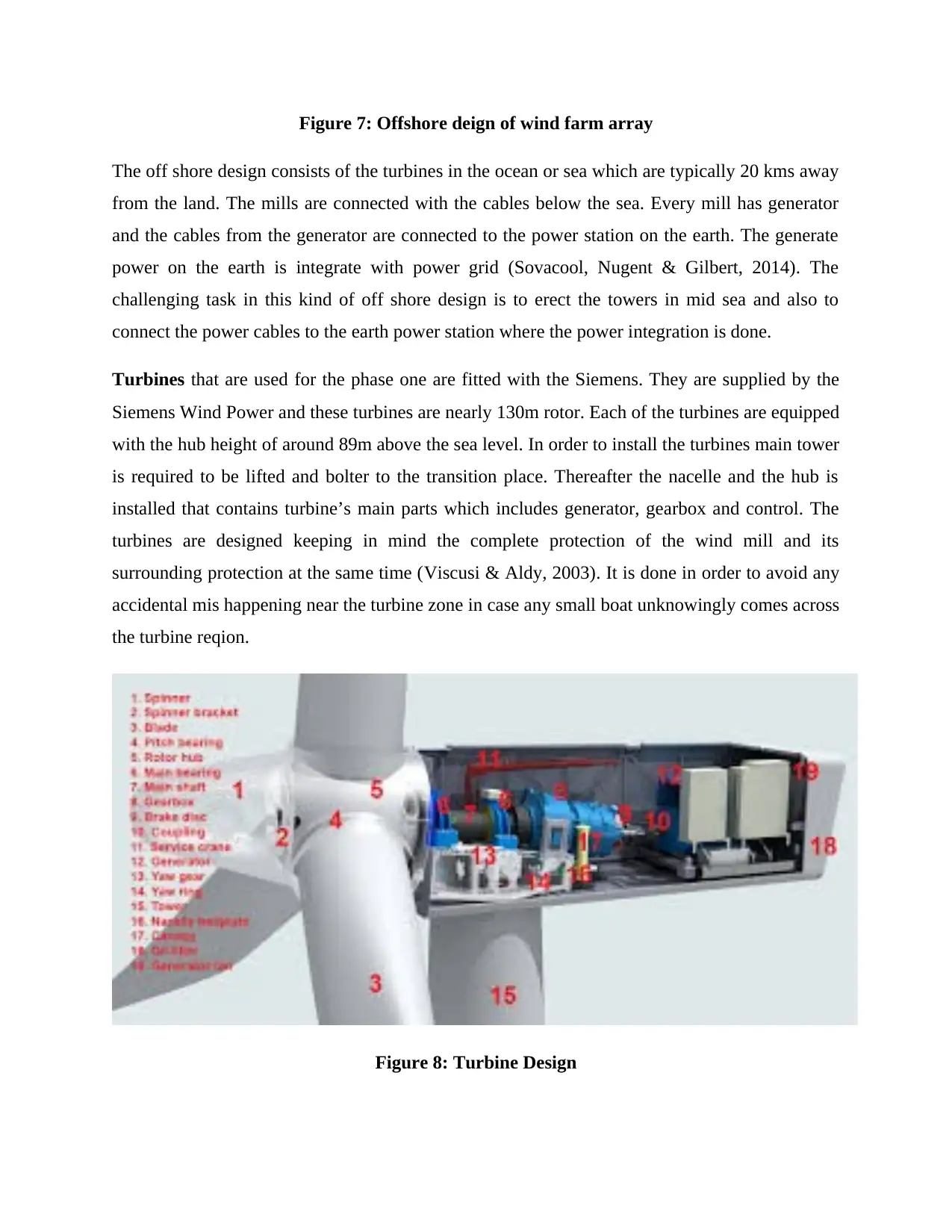
Figure 7: Offshore deign of wind farm array
The off shore design consists of the turbines in the ocean or sea which are typically 20 kms away
from the land. The mills are connected with the cables below the sea. Every mill has generator
and the cables from the generator are connected to the power station on the earth. The generate
power on the earth is integrate with power grid (Sovacool, Nugent & Gilbert, 2014). The
challenging task in this kind of off shore design is to erect the towers in mid sea and also to
connect the power cables to the earth power station where the power integration is done.
Turbines that are used for the phase one are fitted with the Siemens. They are supplied by the
Siemens Wind Power and these turbines are nearly 130m rotor. Each of the turbines are equipped
with the hub height of around 89m above the sea level. In order to install the turbines main tower
is required to be lifted and bolter to the transition place. Thereafter the nacelle and the hub is
installed that contains turbine’s main parts which includes generator, gearbox and control. The
turbines are designed keeping in mind the complete protection of the wind mill and its
surrounding protection at the same time (Viscusi & Aldy, 2003). It is done in order to avoid any
accidental mis happening near the turbine zone in case any small boat unknowingly comes across
the turbine reqion.
Figure 8: Turbine Design
The off shore design consists of the turbines in the ocean or sea which are typically 20 kms away
from the land. The mills are connected with the cables below the sea. Every mill has generator
and the cables from the generator are connected to the power station on the earth. The generate
power on the earth is integrate with power grid (Sovacool, Nugent & Gilbert, 2014). The
challenging task in this kind of off shore design is to erect the towers in mid sea and also to
connect the power cables to the earth power station where the power integration is done.
Turbines that are used for the phase one are fitted with the Siemens. They are supplied by the
Siemens Wind Power and these turbines are nearly 130m rotor. Each of the turbines are equipped
with the hub height of around 89m above the sea level. In order to install the turbines main tower
is required to be lifted and bolter to the transition place. Thereafter the nacelle and the hub is
installed that contains turbine’s main parts which includes generator, gearbox and control. The
turbines are designed keeping in mind the complete protection of the wind mill and its
surrounding protection at the same time (Viscusi & Aldy, 2003). It is done in order to avoid any
accidental mis happening near the turbine zone in case any small boat unknowingly comes across
the turbine reqion.
Figure 8: Turbine Design
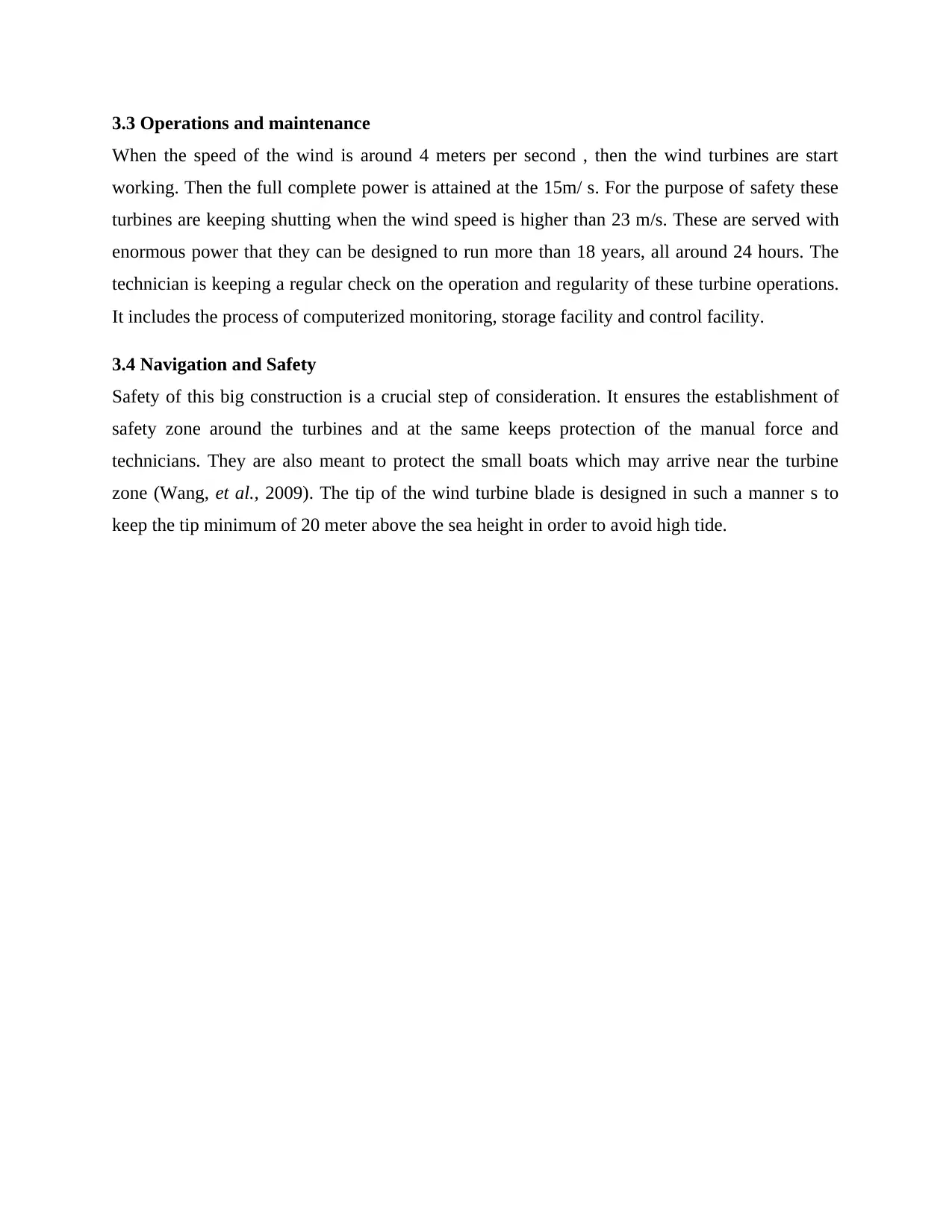
3.3 Operations and maintenance
When the speed of the wind is around 4 meters per second , then the wind turbines are start
working. Then the full complete power is attained at the 15m/ s. For the purpose of safety these
turbines are keeping shutting when the wind speed is higher than 23 m/s. These are served with
enormous power that they can be designed to run more than 18 years, all around 24 hours. The
technician is keeping a regular check on the operation and regularity of these turbine operations.
It includes the process of computerized monitoring, storage facility and control facility.
3.4 Navigation and Safety
Safety of this big construction is a crucial step of consideration. It ensures the establishment of
safety zone around the turbines and at the same keeps protection of the manual force and
technicians. They are also meant to protect the small boats which may arrive near the turbine
zone (Wang, et al., 2009). The tip of the wind turbine blade is designed in such a manner s to
keep the tip minimum of 20 meter above the sea height in order to avoid high tide.
When the speed of the wind is around 4 meters per second , then the wind turbines are start
working. Then the full complete power is attained at the 15m/ s. For the purpose of safety these
turbines are keeping shutting when the wind speed is higher than 23 m/s. These are served with
enormous power that they can be designed to run more than 18 years, all around 24 hours. The
technician is keeping a regular check on the operation and regularity of these turbine operations.
It includes the process of computerized monitoring, storage facility and control facility.
3.4 Navigation and Safety
Safety of this big construction is a crucial step of consideration. It ensures the establishment of
safety zone around the turbines and at the same keeps protection of the manual force and
technicians. They are also meant to protect the small boats which may arrive near the turbine
zone (Wang, et al., 2009). The tip of the wind turbine blade is designed in such a manner s to
keep the tip minimum of 20 meter above the sea height in order to avoid high tide.
⊘ This is a preview!⊘
Do you want full access?
Subscribe today to unlock all pages.

Trusted by 1+ million students worldwide
1 out of 17